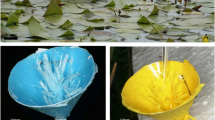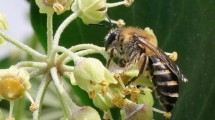Abstract
Many bee species are adapted to just a few specific plants in order to collect pollen (oligolecty). To reproduce successfully, it is important for oligolectic bees to find and recognise the specific host flowers. In this study, we investigated the role of floral volatiles used by an oligolectic bee to recognise its host plants. We compared the attractiveness of natural and synthetic scent samples of host flowers to foraging-naïve and -experienced Hoplitis adunca (Megachilidae) bees that are specialised on Echium and Pontechium (Boraginaceae) plants. The investigations showed that naïve H. adunca females are attracted to 1,4-benzoquinone. During their lifetime, bees learn additional floral cues while foraging on host flowers. In contrast to naïve ones, experienced H. adunca females use, in addition to 1,4-benzoquinone, other compounds to recognise their host plants. 1,4-Benzoquinone is an uncommon floral compound only known from the host plants of H. adunca, and is therefore ideally suited to be used as a plant-specific recognition cue. Several arthropods use this compound to deter insect predators. Therefore, 1,4-benzoquinone as an attractant in Echium flowers may have evolved from a primary function as a defensive compound against insect herbivores.



Similar content being viewed by others
References
Adams RP (2007) Identification of essential oil components by gas chromatography/mass spectrometry. Allured, Carol Stream
Ayasse M (2006) Floral scent and pollinator attraction in sexually deceptive orchids. In: Dudareva N, Pichersky E (eds) Biology of floral scent. CRC, Boca Raton, pp 219–242
Ayasse M, Schiestl FP, Paulus HF, Ibarra F, Francke W (2003) Pollinator attraction in a sexually deceptive orchid by means of unconventional chemicals. Proc R Soc Lond B 270:517–522. doi:10.1098/rspb.2002.2271
Ayasse M, Schiestl FP, Paulus HF, Löfstedt C, Hansson B, Ibarra F, Francke W (2000) Evolution of reproductive strategies in the sexually deceptive orchid Ophrys sphegodes: how does flower-specific variation of odor signals influence reproductive success? Evolution 54:1995–2006. doi:10.1554/0014-3820(2000)054[1995:EORSIT]2.0.CO;2
Ayasse M, Stökl J, Francke W (2011) Chemical ecology and speciation in sexually deceptive orchids. Phytochemistry doi:10.1016/j.phytochem.2011.03.023
Blum MS (1981) 1, 4-Quinones and hydroquinones. In: Blum MS (ed) Chemical defenses of arthropods. Academic, New York, pp 183–205
Brodmann J, Twele R, Francke W, Hoelzler G, Zhang Q-H, Ayasse M (2008) Orchids mimic green-leaf volatiles to attract prey-hunting wasps for pollination. Curr Biol 18:740–744. doi:10.1016/j.cub.2008.04.040
Brodmann J, Twele R, Francke W, Yi-bo L, Xi-qiang S, Ayasse M (2009) Orchid mimics honey bee alarm pheromone in order to attract hornets for pollination. Curr Biol 19:1368–1372. doi:10.1016/j.cub.2009.06.067
Burger H, Ayasse M, Häberlein CM, Schulz S, Dötterl S (2010a) Echium and Pontechium specific floral cues for host plant recognition by the oligolectic bee Hoplitis adunca. S Afr J Bot 76:788–795. doi:10.1016/j.sajb.2010.08.003
Burger H, Dötterl S, Ayasse M (2008) Importance of olfactory and visual cues of Echium for host plant finding of the oligolectic bee Osmia adunca (Megachilidae). Mitt Dtsch Ges Allg Angew Entomol 16:163–166
Burger H, Dötterl S, Ayasse M (2010b) Host plant finding and recognition by visual and olfactory floral cues in an oligolectic bee. Funct Ecol 24:1234–1240. doi:10.1111/j.1365-2435.2010.01744.x
Chambliss OL, Jones CM (1966) Chemical and genetic basis for insect resistance in cucurbits. Proc Am Soc Hort Sci 89:394–405
Cane JH, Sipes SD (2006) Characterizing floral specialization by bees: analytical methods and a revised lexicon for oligolecty. In: Waser NM, Ollerton J (eds) Plant–pollinator interactions: from specialization to generalization. University of Chicago Press, Chicago, pp 99–122
Chen C, Song Q, Proffit M, Bessière J-M, Li Z, Hossaert-McKey M (2009) Private channel: a single unusual compound assures specific pollinator attraction in Ficus semicordata. Funct Ecol 23:941–950. doi:10.1111/j.1365-2435.2009.01622.x
Corbet SA (1978) Bee visits and the nectar of Echium vulgare L. and Sinapis alba L. Ecol Entomol 3:25–37. doi:10.1111/j.1365-2311.1978.tb00900.x
Corey EJ, Schmidt G (1979) Useful procedures for the oxidation of alcohols involving pyridinium dichromate in approtic media. Tetrahedron Lett 20:399–402. doi:10.1016/S0040-4039(01)93515-4
Da Costa CP, Jones CM (1971) Cucumber beetle resistance and mite susceptibility controlled by the bitter gene in Cucumis sativus L. Science 172:1145–1146. doi:10.1126/science.172.3988.1145
Dobson HEM (1987) Role of flower and pollen aromas in host plant recognition by solitary bees. Oecologia 72:618–623. doi:10.1007/BF00378991
Dobson HEM (2006) Relationship between floral fragrance composition and type of pollinator. In: Dudareva N, Pichersky E (eds) Biology of floral scent. CRC, Boca Raton, pp 147–198
Dobson HEM, Bergström G (2000) The ecology and evolution of pollen odors. Plant Syst Evol 222:63–87. doi:10.1007/BF00984096
Dobson HEM, Danielson EM, van Wesep ID (1999) Pollen odor chemicals as modulators of bumble bee foraging on Rosa rugosa Thunb. (Rosaceae). Plant Species Biol 14:153–166. doi:10.1046/j.1442-1984.1999.00020.x
Dötterl S, Füssel U, Jürgens A, Aas G (2005a) 1, 4-Dimethoxybenzene, a floral scent compound in willows that attracts an oligolectic bee. J Chem Ecol 31:2993–2998. doi:10.1007/s10886-005-9152-y
Dötterl S, Jürgens A (2005) Spatial fragrance patterns in flowers of Silene latifolia: lilac compounds as olfactory nectar guides? Plant Syst Evol 255:99–109. doi:10.1007/s00606-005-0344-2
Dötterl S, Jürgens A, Seifert K, Laube T, Weißbecker B, Schütz S (2006) Nursery pollination by a moth in Silene latifolia: the role of odours in eliciting antennal and behavioural responses. New Phytol 169:707–718. doi:10.1111/j.1469-8137.2005.01509.x
Dötterl S, Schäffler I (2007) Flower scent of floral oil-producing Lysimachia punctata as attractant for the oil-bee Macropis fulvipes. J Chem Ecol 33:441–445. doi:10.1007/s10886-006-9237-2
Dötterl S, Vereecken NJ (2010) The chemical ecology and evolution of bee–flower interactions: a review and perspectives. Can J Zool 88:668–697. doi:10.1139/Z10-031
Dötterl S, Wolfe LM, Jürgens A (2005b) Qualitative and quantitative analyses of flower scent in Silene latifolia. Phytochemistry 66:203–213. doi:10.1016/j.phytochem.2004.12.002
Giurfa M, Núñez J, Chittka L, Menzel R (1995) Colour preferences of flower-naive honeybees. J Comp Physiol A Sens Neural Behav Physiol 177:247–259. doi:10.1007/BF00192415
Hegnauer R (1992) Chemotaxonomie der Pflanzen. Birkhäuser, Basel
Jetter R (2006) Examination of the process involved in the emission of scent volatiles from flowers. In: Dudareva N, Pichersky E (eds) Biology of floral scent. CRC, Boca Raton, pp 125–144
Joulain D, König WA (1998) The atlas of spectral data of sesquiterpene hydrocarbons. EB, Hamburg
Kessler A, Halitschke R (2009) Testing the potential for conflicting selection on floral chemical traits by pollinators and herbivores: predections and case study. Funct Ecol 23:901–912. doi:10.1111/j.1365-2435.2009.01639.x
Klinkhamer PGL, de Jong TJ, Wesselingh RA (1991) Implications of differences between hermaphrodite and female flowers for attractiveness to pollinators and seed production. Neth J Zool 41:130–143. doi:10.1163/156854291X00081
Knudsen JT, Eriksson R, Gershenzon J, Stahl B (2006) Diversity and distribution of floral scent. Bot Rev 72:1–120. doi:10.1663/0006-8101(2006)72[1:DADOFS]2.0.CO;2
Minckley RL, Roulston TH (2006) Incidental mutualisms and pollen specialization among bees. In: Waser NM, Ollerton J (eds) Plant–pollinator-interactions: from specialization to generalization. University of Chicago Press, Chicago, pp 69–98
Müller A, Diener S, Schnyder S, Stutz K, Sedivy C, Dorn S (2006) Quantitative pollen requirements of solitary bees: implications for bee conservation and the evolution of bee-flower relationships. Biol Conserv 130:604–615. doi:10.1016/j.biocon.2006.01.023
Müller A, Kuhlmann M (2008) Pollen hosts of western palaearctic bees of the genus Colletes (Hymenoptera: Colletidae): the Asteraceae paradox. Biol J Linn Soc 95:719–733. doi:10.1111/j.1095-8312.2008.01113.x
Norris DM (1970) Quinol stimulation and quinone deterrency of gustation by Scolytus multistriatus (Coleoptera: Scolytidae). Ann Entomol Soc Am 63:476–478
Pellmyr O, Thien L (1986) Insect reproduction and floral fragrances: keys to the evolution of the angiosperms? Taxon 35:76–85
Raguso RA (2008a) Start making scents: the challenge of integrating chemistry into pollination ecology. Entomol Exp Appl 128:196–207. doi:10.1111/j.1570-7458.2008.00683.x
Raguso RA (2008b) Wake up and smell the roses: the ecology and evolution of floral scent. Annu Rev Ecol Evol Syst 39:549–569. doi:10.1146/annurev.ecolsys.38.091206.095601
Reese JC, Beck SD (1976) Effects of allelochemics on the Black Cutworm, Agrotis ipsilon; effects of p-benzoquinone, hydroquinone, and duroquinone on larval growth, development, and utilization of food. Ann Entomol Soc Am 69:59–67
Robertson C (1925) Heterotropic bees. Ecology 6:412–436. doi:10.2307/1929107
Schaefer HM, Schaefer V, Levey DJ (2004) How plant-animal interactions signal new insights in communication. Trends Ecol Evol 19:577–584. doi:10.1016/j.tree.2004.08.003
Schiestl FP (2005) On the success of a swindle: pollination by deception in orchids. Naturwissenschaften 92:255–264. doi:10.1007/s00114-005-0636-y
Schiestl FP (2010) The evolution of floral scent and insect chemical communication. Ecol Lett 13:643–656. doi:10.1111/j.1461-0248.2010.01451.x
Schiestl FP, Ayasse M (2001) Post-pollination emission of a repellent compound in a sexually deceptive orchid: a new mechanism for maximising reproductive success? Oecologia 126:531–534. doi:10.1007/s004420000552
Schiestl FP, Ayasse M, Paulus HF, Löfstedt C, Hansson BS, Ibarra F, Francke W (1999) Orchid pollination by sexual swindle. Nature 399:421–422. doi:10.1038/20829
Schulz S, Gross J, Hilker M (1997) Origin of the defensive secretion of the leaf beetle Chrysomela lapponica. Tetrahedron 53:9203–9212. doi:10.1016/S0040-4020(97)00618-2
da Silva UF, Borbac EL, Semir J, Marsaioli AJ (1999) A simple solid injection device for the analyses of Bulbophyllum (Orchidaceae) volatiles. Phytochemistry 50:31–34. doi:10.1016/S0031-9422(98)00459-2
Svensson GP, Okamoto T, Kawakita A, Goto R, Kato M (2010) Chemical ecology of obligate pollination mutualisms: testing the ‘private channel’ hypothesis in the Breynia–Epicephala association. New Phytol 186:995–1004. doi:10.1111/j.1469-8137.2010.03227.x
Thomson JD (2003) When it is mutualism? Am Nat 162:S1–S9. doi:10.1086/378683
Thomson RH (1997) Naturally occuring quinones IV. Chapman and Hall, London
Watanabe N, Watanabe S, Nakajima R, Moon J-H, Shimokihara K, Inagaki J, Etoh H, Asai T, Sakata K, Ina K (1993) Formation of flower fragrance compounds from their precursors by enzymic action during flower opening. Biosci Biotech Biochem 57:1101–1106
Whitehead MR, Peakall R (2009) Integrating floral scent, pollination ecology and population genetics. Funct Ecol 23:863–874. doi:10.1111/j.1365-2435.2009.01620.x
Acknowledgments
We gratefully acknowledge Paulo Milet-Pinheiro for his critical reading, David Ponting for his linguistic advice, and two anonymous reviewers gave valuable comments on earlier versions of this manuscript. H.B. wishes to thank the Studienstiftung des deutschen Volkes for financial support. All experiments comply with the current laws of the country in which they were performed: in this case, Germany.
Author information
Authors and Affiliations
Corresponding author
Additional information
Communicated by Diethart Matthies.
Electronic supplementary material
Below is the link to the electronic supplementary material.
Rights and permissions
About this article
Cite this article
Burger, H., Dötterl, S., Häberlein, C.M. et al. An arthropod deterrent attracts specialised bees to their host plants. Oecologia 168, 727–736 (2012). https://doi.org/10.1007/s00442-011-2136-4
Received:
Accepted:
Published:
Issue Date:
DOI: https://doi.org/10.1007/s00442-011-2136-4




